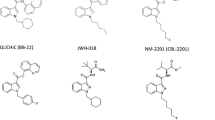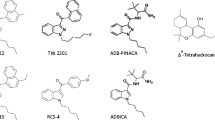Abstract
While many previous studies have shown that a variety of cannabinoids substitute and cross-substitute for Δ9-tetrahydrocannabinol (THC) in drug discrimination procedures, few have systematically examined potential THC-like effects of non-cannabinoid compounds. The purpose of the present study was to delineate further the pharmacological specificity of THC discrimination. Rats were trained to discriminate THC (3.0 mg/kg) from vehicle. Following determination of a dose-effect curve with THC, substitution tests with selected compounds from a variety of pharmacological classes, includingl-phenylisopropyl adenosine, dizocilpine, dextromethorphan, clozapine, buspirone, MDL 72222, muscimol, midazolam and chlordiazepoxide, were performed. Whereas THC produced full dose-dependent substitution, substitution tests with non-cannabinoid drugs resulted in less than chance (50%) levels of responding on the THC-appropriate lever, with the exception of (+)-MDMA (2.5 mg/kg, 50%) and diazepam (3.0 mg/kg, 67%). These results are consistent with those of previous studies and suggest that the discriminative stimulus effects of THC exhibit pharmacological specificity.
Similar content being viewed by others
References
Balster RL, Ford RD (1978) The discriminative stimulus properties of cannabinoids: a review. In: Ho BT, Richards DW, Chute DL (eds) Drug discrimination and state dependent learning. Academic Press, New York, pp 131–147
Balster RL, Prescott WR (1992) δ9-Tetrahydrocannabinol discrimination in rats as a model for cannabis intoxication. Neurosci Biobehav Rev 16:55–62
Browne RG, Weissman A (1981) Discriminative stimulus properties of δ9-tetrahydrocannabinol: mechanistic studies. J Clin Pharmacol 21:227S-234S
Compton DR, Gold LH, Ward SJ, Balster RL, Martin BR (1992) Amino-alkylindole analogs: cannabimimetic activity of a class of compounds structurally distinct from δ9-tetrahydrocannabinol. J Pharmacol Exp Ther 263:1118–1126
Gold LH, Balster RL, Barrett RL, Britt DT, Martin BR (1992) A comparison of the discriminative stimulus properties of δ9-tetrahydrocannabinol and CP 55,940 in rats and rhesus monkeys. J Pharmacol Exp Ther 262:479–486
Hollister LE, Gillespie HK (1990) The benzodiazepine receptor antagonist, flumazenil, does not block clinical effects of delta-9-tetrahydrocannabinol. Life Sci 47:1655–1660
Järbe TUC, Hiltunen AJ (1987) Cannabimimetic activity of cannabinol in rats and pigeons. Neuropharmacology 26:19–228
Järbe TUC, Hiltunen AJ (1988) Limited stimulus generalization between δ9-THC and diazepam in pigeons and gerbils. Psychopharmacology 94:328–331
Järbe TUC, McMillan (1979) Discriminative stimulus properties of tetrahydrocannabinols and related drugs in rats and pigeons. Neuropharmacology 18:1023–1024
Kelly TH, Foltin RW, Emurian CS, Fischman MW (1993) Performance-based testing for drugs of abuse: dose and time profiles of marijuana, amphetamine, alcohol, and diazepam. J Anal Toxicol 17:264–272
Mokler DJ, Nelson BD, Harris LS, Rosecrans JA (1986) The role of benzodiazepine receptors in the discriminative stimulus properties of δ9-tetrahydrocannabinol. Life Sci 38:1581–1589
Onaivi ES, Green MR, Martin BR (1990) Pharmacological characterization of cannabinoids in the elevated plus maze. J Pharmacol Exp Ther 253:1002–1009
Pertwee RG (1988) The central neuropharmacology of psychotropic cannabinoids. Pharmacol Ther 36:189–261
Pertwee RG (1992) In vivo interactions between psychotropic cannabinoids and other drugs involving central and peripheral neurochemical mediators. In: Murphy L, Bartke A (eds) Marihuana/cannabinoids: neurobiology and neurophysiology. CRC Press, Boca Raton, Fla., pp 165–218
Pertwee RG, Greentree SG (1988) Delta-9-tetrahydrocannabinol-induced catalepsy in mice is enhanced by pretreatment with flurazepam or chlordiazepoxide. Neuropharmacology 27:485–491
Pertwee RG, Wickens AP (1991) Enhancement by chlordiazepoxide of catalepsy induced in rats by intravenous or intrapallidal injections of enantiomeric cannabinoids. Neuropharmacology 30:237–244
Pertwee RG, Greentree SG, Swift PA (1988) Drugs which stimulate or facilitate central GABAergic transmission interact synergistically with delta-9-tetrahydrocannabinol to produce marked catalepsy in mice. Neuropharmacology 27:1265–1270
Sethi BB, Trivedi JK, Kumar P, Gulati A, Agarwal AK, Sethi N (1986) Antianxiety effect of cannabis: involvement of central benzodiazepine receptors. Biol Psychiatry 21:3–10
Sung S-C, Jakobovic A (1987) Interaction of a water-soluble derivative of δ9-tetrahydrocannabinol with [3H]flunitrazepam binding to rat brain membranes. Prog Neuro-Psychopharmacol Biol Psychiatry 11:335–340
Wiley JL, Barrett RL, Britt DT, Balster RL, Martin BR (1993) Discriminative stimulus effects of δ9-tetrahydrocannabinol and δ9–11-tetrahydrocannabinol in rats and rhesus monkeys. Neuropharmacology 32:359–365
Wiley JL, Barrett RL, Lowe J, Balster RL, Martin BR (1995) Discriminative stimulus effects of CP 55,940 and structurally dissimilar cannabinoids in rats. Neuropharmacology, in press
Yamamoto I, Kimura T, Yoshida H, Watanabe K, Yoshimura H (1992) Cannabinoid metabolite interacts with benzodiazepine receptor. Res Commun Subst Abuse 13:299–313
Author information
Authors and Affiliations
Rights and permissions
About this article
Cite this article
Barrett, R.L., Wiley, J.L., Balster, R.L. et al. Pharmacological specificity of Δ9-tetrahydrocannabinol discrimination in rats. Psychopharmacology 118, 419–424 (1995). https://doi.org/10.1007/BF02245942
Received:
Revised:
Issue Date:
DOI: https://doi.org/10.1007/BF02245942




